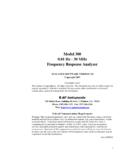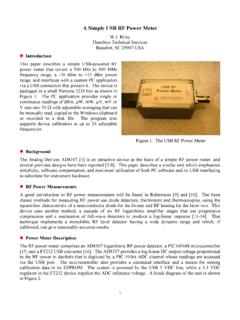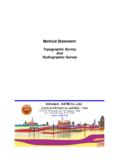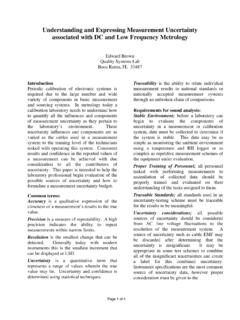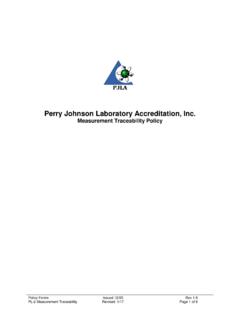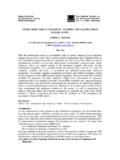Transcription of Model 300 0.01 Hz - 30 MHz Frequency Response …
1 I Model 300 Hz - 30 MHz Frequency Response analyzer analyzer SOFTWARE VERSION Copyright 2015 Copyright Notice This manual is copyrighted. All rights reserved. This document may not, in whole or part, be copied, reproduced, reduced or translated by any means, either mechanical or electronic, without prior consent in writing from AP Instruments. AP Instruments 355 Tesconi Circle, Suite #A, Santa Rosa, CA. 95401 Phone: (707) 544-2170 Fax: (707) 544-5816 Web: Federal Communications Requirements Warning- This equipment generates, uses, and can radiate radio Frequency energy and if not installed and used in accordance with the instruction manual, may cause interference to radio communications.
2 It has been tested and found to comply with the limits for a class A computing device pursuant to Subpart J of Part 15 of FCC rules, which are designed to provide reasonable protection against such interference when operated in a commercial environment. Operation of this equipment in residential areas is likely to cause interference in which case the user at his own expense will be required to take whatever measures may be required to correct the interference. Doc# 000323 ii The Model 300 Frequency Response analyzer The Model 300 Frequency Response analyzer system is composed of an integrated source/receiver unit, probes, interface cables and software for a user provided Windows based computer.
3 The Model 300 Frequency Response analyzer offers the following high performance features Hertz to 30 Megahertz coverage 110 dB's of dynamic range with dB mag. and degree phase accuracy Up to 10,001 measurement points with linear or logarithmic Frequency sweeps Automatic magnitude and phase correction compensates for test leads or fixtures Graphical interface features Windows based graphical user interface with real time plotting Virtual instrument front panel for complete access to all system parameters Automatic or manual scaling and shifting of screen plots for optimum viewing Advanced marker functions and master graphs give data and delta readouts.
4 Advanced functions including complex impedance Source features Direct digital synthesis for fast sweeps Hertz to 30 MHz range, Hertz resolution Output level adjustable from millivolts to volts rms (20 Vpp) Selectable 2 ohm or 50 ohm output impedance with 500mA peak output current Output can be DC offset up to +/- 10 V eliminating large coupling capacitors at low measurement frequencies User programmable variable source level with Frequency iii Receiver features Two channels for B/A ratioed, transfer function measurements High selectivity two stage receiver architecture for high noise immunity Digital signal processing provides a user selectable IF bandwidth.
5 Optimizing noise immunity and measurement speed Selectable AC (>=10Hz) or DC coupling with one megohm input impedance Inputs can be DC offset up to +/- 8 V facilitating DC coupled measurements Table Of Contents iv Chapter 1 : System Installation .. 7 Hardware Installation .. 7 Software Installation .. 9 Chapter 2 : Virtual Front Panel Operation .. 11 Software Overview .. 11 Graph Display Modes .. 14 The Graph Window .. 15 The Data Window .. 17 Menu Selections .. 20 File Menu .. 20 Edit Menu.
6 22 View Menu .. 23 Graph Menu .. 25 Tools Menu .. 26 Probe Calibration .. 38 Toolbars .. 41 Main Toolbar .. 41 Sweep Control Toolbar .. 43 Sweep Frequency Toolbar .. 45 Source Parameters Toolbar .. 46 Receiver Parameters Toolbar .. 48 Graph Tools Toolbar .. 49 Marker Functions Toolbar .. 51 Chapter 3 : Data Transfer .. 53 Data Files .. 53 Image Files .. 54 The Clipboard .. 55 Dynamic Data Exchange (DDE) .. 56 Data Links Reference .. 57 Execute Links Reference .. 61 Using DDE in Microsoft Excel .. 64 v Chapter 4 : Application Notes.
7 71 Introduction to Analog Network Measurements .. 71 Basic Measurement Procedures .. 73 High Frequency Measurements .. 75 Circuits with Nonzero DC Voltage Levels at the Input / Output Node .. 76 Measuring Circuits with High Common Mode Voltages .. 76 Measuring Feedback Loop Frequency Response .. 77 Measuring Complex Impedance .. 81 Line Current Harmonic Measurements .. 83 Power Transmission/Reflection Measurements .. 84 Appendices .. 87 Appendix A: Theory of Operation .. 87 Appendix B: Measurement Accuracy.
8 88 Appendix C: Specifications .. 92 Appendix D: File Types; Use and Format .. 95 Appendix E: Default Setup Values .. 98 Appendix F: Repair and Warranty Information .. 100 Appendix G: AC Power Fuse Replacement .. 102 Appendix H: System Calibration / Performance Verification .. 103 Quick Performance Test .. 103 Full Performance Tests .. 104 Index .. 113 Safety Notices .. 116 7 1 System Installation Hardware Installation [[ Note: Perform software installation prior to powering up the analyzer ]] Host PC requirements for using the analyzer Operating System: Windows versions XP, Vista, Windows 7, Windows 8 PC Hardware: 1 GHz processor or faster recommended, USB port.
9 XVGA video card resolution or higher. Verify that the local AC mains voltage level matches the setting of the line voltage selector switch on the rear panel. Set the switch as required for the AC mains supply, either 115 VAC or 230 VAC as appropriate. If the line selector switch was initially in the incorrect position then the fuses will need to be inspected and possibly replaced with the correct values since different fuses are used for 115 VAC and 230 VAC. See appendix G for instructions on replacing the fuses.
10 Using the provided AC power cord connect the cord to the analyzer s rear panel mains input while plugging the other end of the cord into the AC mains. Turn on the analyzer s front panel power switch. The green power light should be on. Now turn off the power switch in preparation for the software installation. Connect the analyzer s rear panel USB connector to the host PC's USB port using the provided USB cable. Connect the source probe, a 1:1 cable with clips, to the source output BNC. Connect the two input probes, labeled "A" and "B" to their respective BNC's.
